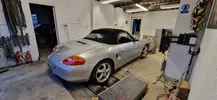There is more to life with TurboRenault.co.uk
You are using an out of date browser. It may not display this or other websites correctly.
You should upgrade or use an alternative browser.
You should upgrade or use an alternative browser.
Steve Swan
Well-Known Member
The path to the Dark sideGot me looking at sick 911's......naughty boy...
Steve Swan
Well-Known Member

Audi A4/Porsche Boxster 986 ATB Differential
The Audi A4/Porsche Boxster 986 ATB Differential is the perfect upgrade of choice for car owners and motorsport competitors looking to improve their vehicle’s traction.
shop.quaife.co.uk
Maybe there will be a January sale...
Duncan Grier
Well-Known Member
Porsche Boxster (986): review, history and specs of an icon | Evo
It was the car that saved Porsche and the original Boxster remains as sweet, sorted and satisfying today as it was 25 years ago
 www.evo.co.uk
www.evo.co.uk
Made a start on the Christmas mods. First up has been the decat pipes. Hopefully it'll help it breath a little better and give it a more sporty soundtrack. Not too bad of a job on the driveway. The cats to back box pipework is all clamped/sleeve joints so a little penetrating fluid and a few taps of the hammer things begin to move. The cat to manifold bolts were all rusted away though, easy enough to slice the lower 2 off on both sides but the uppers were a pain. Some interesting hacksaw action and took the heads off with a hammer and punch. Once they were off the pipes came out with ease. Some fiddling with the lambda connectors but nowt too hard. Considering the age of the car most things have come off or out with ease. Its the first time I've had a proper good look underneath the car and its so well put together and designed, most parts look to have been thought out not only to work well but to give a mechanic/engineer good access. I've ordered up 2 x step down lap joint clamps for joining the bigger decat pipes to the oem back box. Unfortunately these probably wont be here for a week or two. Next up when I get some spare time will be the K&N air filter and underdrive pulley along with 9ltrs of oil and an oil filter.
Thanks for reading and Merry Christmas

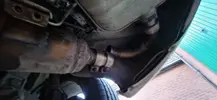
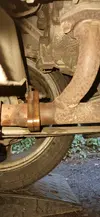
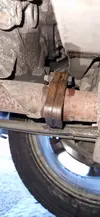
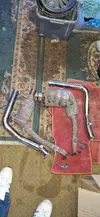
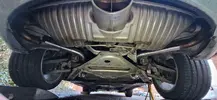
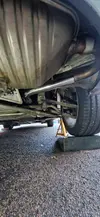
Thanks for reading and Merry Christmas







Last edited:
Duncan Grier
Well-Known Member
Just going to plonk this here... a few people who have watched my vids over the years may have heard me mention doing this exact thing. I've been following this build for a while. Pushing a stock block but does have a decent exhaust and big turbo on, plus a half decent ecu controlling it. Chap from the Volks Workshop has slapped it together 
Steve Swan
Well-Known Member
Interesting, unfortunately not in a good way. What were the ambient temperatures and humidity compared to last time and seriously tyre pressures..............
Dropping back pressure in the exhaust can drop the torque on a road engine for sure, seems counter intuitive, but the evidence is there.
N/A tuning starts at the air intake and finishes at the exhaust tip. Porsche probably burnt a few hours on the dyno getting the best from their set up. Looking forward to the next instalment even if you're not.
My mate is at me to lengthen the exhaust on the Dauph. He managed to double the length on a Race Fiat X19 1500 single cam he looks after with a couple of 180 degree bends, which I was kinda unsure of, but the power gains across the range are large and it has went from being very top endy, to having a better spread. It is up 20 BHP at 5k which did get my attention
Dropping back pressure in the exhaust can drop the torque on a road engine for sure, seems counter intuitive, but the evidence is there.
N/A tuning starts at the air intake and finishes at the exhaust tip. Porsche probably burnt a few hours on the dyno getting the best from their set up. Looking forward to the next instalment even if you're not.
My mate is at me to lengthen the exhaust on the Dauph. He managed to double the length on a Race Fiat X19 1500 single cam he looks after with a couple of 180 degree bends, which I was kinda unsure of, but the power gains across the range are large and it has went from being very top endy, to having a better spread. It is up 20 BHP at 5k which did get my attention
Temps and humidity were different but the dyno actually adjusts for that. The correction factor that was applied wasn't wildly different between the days and not enough to cause the difference seen in output so I'm told by the owner/operator.
Exhaust wise the manifolds/early setup I have seem to be the one that people go for when upgrading and decating. That said every person doing may just be doing so as 1 person once said it was the thing to do but did no testing later cars have an integrated cat in the manifold and a second each side in the downpipe.
later cars have an integrated cat in the manifold and a second each side in the downpipe.
I will do some basic checks and testing before heading back, just to satisfy curiosity. I've also started doing to some research and digging on the ecu that's fitted. It's a very old style/type and very crude to be fair. But does seem to be easily mapable to make changes. I will report back soon
Exhaust wise the manifolds/early setup I have seem to be the one that people go for when upgrading and decating. That said every person doing may just be doing so as 1 person once said it was the thing to do but did no testing
I will do some basic checks and testing before heading back, just to satisfy curiosity. I've also started doing to some research and digging on the ecu that's fitted. It's a very old style/type and very crude to be fair. But does seem to be easily mapable to make changes. I will report back soon
Steve Swan
Well-Known Member
When my mate built his first Ford V8, for a customers Sunbeam Tiger, naturally we were all curious to see what it was like on the Dyno. He had gone in at lunchtime to see how it was going and remarked on the warmth in the Dyno room. Iain then decided to open all the doors (as the rest of the staff were at lunch ) and run it up where it promptly gained 30 BHP. I know it was a 5 litre. Cold damp days are always best for engines.
Be interesting to see what you findout with this.
I know many say about cone filters killing mafs, you don't really hear about it with panel filters, but it is possible that the oil already on the filter, combined with what you added to the tray it sits on / in, once warm, could be finding it's way to the maf and sapping some of those ponies.
I know many say about cone filters killing mafs, you don't really hear about it with panel filters, but it is possible that the oil already on the filter, combined with what you added to the tray it sits on / in, once warm, could be finding it's way to the maf and sapping some of those ponies.
Just as a side note the dyno operator (hes not just that btw he has many years of calibration and tech support for after market and oem ecu's) told me roughly how much hp swing there is with temp and showed the workings. The maths for calculating the difference in temp to horsepower are available online if any one fancies a look, its never as much as people think it is. 11C change is worth a shave over 1% HP swing, obviously the more you make the bigger the swing. The difference in my day should have been around 1.5bhp not the 14bhp we saw lost. Also humidity does come into it. Most dyno cells with have a humidity, temp and barometric pressure wired into them so that the software makes all the calculations giving an adjusted (to a standard) reading for consistency. So even though a car feels faster on a cold day and is making more power when it comes down to it being on the dyno it should still read near enough the same if middle of summer or winter.
Be interesting to see what you findout with this.
I know many say about cone filters killing mafs, you don't really hear about it with panel filters, but it is possible that the oil already on the filter, combined with what you added to the tray it sits on / in, once warm, could be finding it's way to the maf and sapping some of those ponies.
you aren't the first to mention it. In fact ive had multiple messages on social media from people who have had the same issue when fitting this brand of filter. One had back to back 9bhp losses. Ill try and clean and inspect the MAF first then do some logs of it with no filter, the oem and the aftermarket and report back.
Copy and Paste for anyone wanting the maths
"We all know about the dangers of high manifold temperatures, and the destructive effects of detonation. It’s the primary reason for the use of an intercooler with most forced induction systems, including superchargers and turbochargers. But there is another benefit to cool air: it is denser, and contains more oxygen than warm air. An increase in the oxygen density of the intake air will allow for the use of more fuel. This not only increases the available horsepower of an engine, but allows for a more complete burn, which results in greater overall efficiency.
There is a general rule among hot rodders that ten degrees of temperature is equal to about 1 percent of horsepower. While that may provide for a quick estimate of the effects of temperature on horsepower, it isn’t a very accurate measure. Part of the reason for this is that the density of air at 90 degrees is lower than the density of air at 60 degrees, so changing the temperature by ten degrees has a different effect on 90 degree air than it does on 60 degree air.
Horsepower change is dependent on the square root of the change in air temperature expressed as “absolute temperature.” On an absolute temperature scale, there is no possibility of a negative measurement because the value of zero represents the lowest temperature possible for any matter. On such a scale, zero is known as “absolute zero.”
When using the Fahrenheit scale, absolute zero is equal to approximately -460 degrees. So in order to convert degrees Fahrenheit to absolute degrees, all that is need is to add 460 to the temperature on the thermometer. 40 degrees Fahrenheit is thus equal to 500 degrees on the absolute scale; 75 degrees Fahrenheit is equal to 535 degrees on the absolute scale, and so on.
In physics terms, the temperature coefficient of horsepower is a negative one. That is, the higher the temperature, the lower the air density and as a result, the lower the horsepower. Because of this, we can’t simply establish a ratio between the beginning and ending temperatures, we will have to use the inverse ratio instead. So, the formula for calculating a change in horsepower as a result of a change in temperature is as follows, where HP = horsepower and T= temperature:
HP2 / HP1 = square root of (T1 / T2)
The horsepower at temperature 2 divided by the horsepower at temperature 1 is equal to the square root of the result of temperature 1 divided by temperature 2.
Example 1
An engine with 200 horsepower at 75 degrees will have how much power at 55 degrees? (Remember to express both temperatures in absolute terms by adding 460)
HP2/200 =square root of (535/515)
HP2/200 =square root of 1.0388
HP2/200 =1.0192
HP2 =1.0192 x 200
HP2 = 203.85
In other words, reducing the intake air temperature by 20 degrees gives this engine an extra 3.85 horses.
Example 2
Same 200 horsepower engine, cooled to 50 degrees.
HP2/200 = square root of (535/510)
HP2/200 = square root of 1.049
HP2/200 = 1.024
HP2 = 1.024 x 200
HP2 = 204.80
Example 3
Same 200 horsepower engine at 95 degrees F.
HP2 /200 = square root of (535/555)
HP2/200 = square root of 0.964
HP2/200 = 0.982
HP2 = 0.982 x 200
HP2 = 196.4
So raising the temperature of the intake air by 20 degrees reduces our horsepower by 3.6.
By Vanessa Wilson
"We all know about the dangers of high manifold temperatures, and the destructive effects of detonation. It’s the primary reason for the use of an intercooler with most forced induction systems, including superchargers and turbochargers. But there is another benefit to cool air: it is denser, and contains more oxygen than warm air. An increase in the oxygen density of the intake air will allow for the use of more fuel. This not only increases the available horsepower of an engine, but allows for a more complete burn, which results in greater overall efficiency.
There is a general rule among hot rodders that ten degrees of temperature is equal to about 1 percent of horsepower. While that may provide for a quick estimate of the effects of temperature on horsepower, it isn’t a very accurate measure. Part of the reason for this is that the density of air at 90 degrees is lower than the density of air at 60 degrees, so changing the temperature by ten degrees has a different effect on 90 degree air than it does on 60 degree air.
Horsepower change is dependent on the square root of the change in air temperature expressed as “absolute temperature.” On an absolute temperature scale, there is no possibility of a negative measurement because the value of zero represents the lowest temperature possible for any matter. On such a scale, zero is known as “absolute zero.”
When using the Fahrenheit scale, absolute zero is equal to approximately -460 degrees. So in order to convert degrees Fahrenheit to absolute degrees, all that is need is to add 460 to the temperature on the thermometer. 40 degrees Fahrenheit is thus equal to 500 degrees on the absolute scale; 75 degrees Fahrenheit is equal to 535 degrees on the absolute scale, and so on.
In physics terms, the temperature coefficient of horsepower is a negative one. That is, the higher the temperature, the lower the air density and as a result, the lower the horsepower. Because of this, we can’t simply establish a ratio between the beginning and ending temperatures, we will have to use the inverse ratio instead. So, the formula for calculating a change in horsepower as a result of a change in temperature is as follows, where HP = horsepower and T= temperature:
HP2 / HP1 = square root of (T1 / T2)
The horsepower at temperature 2 divided by the horsepower at temperature 1 is equal to the square root of the result of temperature 1 divided by temperature 2.
Example 1
An engine with 200 horsepower at 75 degrees will have how much power at 55 degrees? (Remember to express both temperatures in absolute terms by adding 460)
HP2/200 =square root of (535/515)
HP2/200 =square root of 1.0388
HP2/200 =1.0192
HP2 =1.0192 x 200
HP2 = 203.85
In other words, reducing the intake air temperature by 20 degrees gives this engine an extra 3.85 horses.
Example 2
Same 200 horsepower engine, cooled to 50 degrees.
HP2/200 = square root of (535/510)
HP2/200 = square root of 1.049
HP2/200 = 1.024
HP2 = 1.024 x 200
HP2 = 204.80
Example 3
Same 200 horsepower engine at 95 degrees F.
HP2 /200 = square root of (535/555)
HP2/200 = square root of 0.964
HP2/200 = 0.982
HP2 = 0.982 x 200
HP2 = 196.4
So raising the temperature of the intake air by 20 degrees reduces our horsepower by 3.6.
By Vanessa Wilson
Steve Swan
Well-Known Member
Only one way to find out........... Spend a fortune at the rollers on different days and check the differences. Personally I think there is more to be gained or lost by getting this right or wrong, than the maths suggests. One thing missed out is slip on the rollers also. An Engine Dyno is bolted to the crank there is no slip possible between crank and device, therefore better accuracy. This is something anyone with a Dyno will never tire telling you.
There is no doubt as far as I'm concerned a run on the Dyno for your freshly built engine is the way to go. You can get straight on and kick it's head after installation. It will do a better job of settling the bores, esp. on race engines as there is no practical way to run them in on the road.
Being stuck in the real world with an engine you want to maximise it's potential, as cheaply as possible, makes the rollers the only sensible option. I still wonder about the de-cat pipes adversly affecting the engines scavenging though. I think we can all agree that the exhaust is way too short to be ideal on this type installation, so the manufacturer did some sneaky stuff to get it to work well.
Fitting full race carbs,manifolds and exhaust to a stock motor will almost always have a negative effect as all they will do is reduce the airspeed through the system. You need to improve the pump to make their fitment necessary.
This is the thing that fascinates me most about the Hot car hobby, Finding out how each mod affects the output, pity I've never had enough spare cash to pursue it more than I have, and we are all in the same boat here. It's why this forum is so interesting as we can see each others successes or failures and hopefully learn something and save a few bob going forward.
Happy Motoring
There is no doubt as far as I'm concerned a run on the Dyno for your freshly built engine is the way to go. You can get straight on and kick it's head after installation. It will do a better job of settling the bores, esp. on race engines as there is no practical way to run them in on the road.
Being stuck in the real world with an engine you want to maximise it's potential, as cheaply as possible, makes the rollers the only sensible option. I still wonder about the de-cat pipes adversly affecting the engines scavenging though. I think we can all agree that the exhaust is way too short to be ideal on this type installation, so the manufacturer did some sneaky stuff to get it to work well.
Fitting full race carbs,manifolds and exhaust to a stock motor will almost always have a negative effect as all they will do is reduce the airspeed through the system. You need to improve the pump to make their fitment necessary.
This is the thing that fascinates me most about the Hot car hobby, Finding out how each mod affects the output, pity I've never had enough spare cash to pursue it more than I have, and we are all in the same boat here. It's why this forum is so interesting as we can see each others successes or failures and hopefully learn something and save a few bob going forward.
Happy Motoring
Similar threads
- Replies
- 4
- Views
- 105



